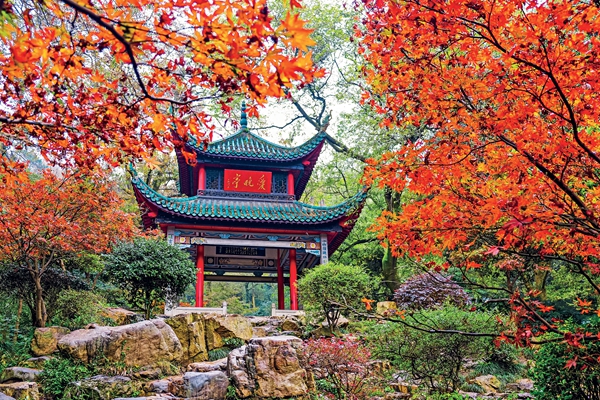Exploring Iconic Mountains While Leaf Peeping

As the vibrant colors of autumn blanket the country, it is the ideal time to admire China's stunning maple leaves. In this issue, Women of China English Monthly recommends several enchanting sightseeing destinations, each of which is renowned for its mesmerizing autumn landscape.
Reveling in the breathtaking scenery of autumn-colored leaves is a tradition in China that dates back to ancient times. Du Mu, a well-known poet during the Tang Dynasty (618-907), depicted an attractive autumn scene in a poem. He wrote: "I stop my cart to enjoy the maples in twilight hours; The frosty leaves are redder than spring flowers."
There are four renowned sites among China's top leaf-peeping destinations. They are: Xiangshan Park, in Beijing; Qixia Mountain, in Nanjing, capital of East China's Jiangsu Province; Tianping Mountain, in Suzhou, a city in Jiangsu Province; and, Yuelu Mountain, in Changsha, capital of Central China's Hunan Province.

Xiangshan Park is located in the western suburbs of Beijing. Xiangshan, with a history of nearly 900 years, was an imperial garden during ancient times. It was where the emperors — during the Yuan (1206-1368), Ming (1368-1644) and Qing (1616-1911) dynasties — hunted and escaped the summer heat.
Xiangshan scenery differs from season to season. However, autumn is the best time of year to enjoy the park's natural beauty. The mountain is adorned with thousands of smoke trees (a large, bushy deciduous shrub with autumn-colored leaves and feathery inflorescences). The forest undergoes a spectacular transformation during autumn; the leaves gradually change from green to red, causing the area to become a sea of red leaves. The mountain becomes a dreamlike scene when this happens. Peak viewing time to see Xiangshan's red leaves is from mid-October to mid-November.
Qixia Mountain, referred to as She Mountain during ancient times, is located in the northeastern part of Nanjing. Qixia Mountain is a picturesque and historically significant destination, and it captivates visitors with its natural beauty and cultural heritage.

With more than 10 varieties of red leaves, and hundreds of centuries-old maple trees, the autumn splendor of Qixia Mountain has long been eulogized in poems, by literati, throughout China's history. Late autumn is the best time to view the red leaves on the mountain. Every year, the changing colors of the maple leaves are prevalent from mid-November to midDecember. During that time, the mountain is adorned with yellow, orange and red leaves, which creates a picturesque autumn scene. The breathtaking scene grabs the attention of residents and visitors alike. As they walk along the trails, people become immersed in the natural beauty. It is an ideal place for city dwellers to escape the hustle and bustle of modern life.
Qixia Mountain offers the unique blend of a stunning natural landscape, and abundant cultural heritage. The mountain is home to several Buddhist temples. Among them, Qixia Temple is the most famous. The temple, with a history of more than 1,500 years, is renowned for its exquisite architecture and Buddhist stone carvings.
Tianping Mountain is located in Wuzhong, a district in Suzhou. The mountain is known for its strange rock formations, crystal-clear springs and red maple trees. Collectively, they are referred to as the "three wonders of Tianping Mountain."

It has been said the oldest maple grove on Tianping Mountain dates back to the Ming Dynasty. The trees were transplanted from Southeast China's Fujian Province by Fan Yunlin, a 17th-generation descendant of Fan Zhongyan (989-1052), a prominent writer and politician during the Song Dynasty (960-1279). The 400-year-old maples are more than 20 meters in height, and their leaves are triangular in shape. When the cold dew arrives, the leaves do not turn red all at once. Instead, they turn yellow from green, to orange, and then purple, with different colored leaves appearing on the same tree. Thus, the trees are commonly referred to as "five-colored maples." As the autumn breeze rustles through the forest, the leaves create dreamy scenes, straight out of fairy tales.
Yuelu Mountain is situated on the west bank of Xiangjiang River, in Changsha. Covered by nearly 1,000 species of plants, the mountain is an outdoor "botanical museum." In summer, the mountain is lush and green, offering a magnificent landscape for travelers and nature enthusiasts. During late autumn, the fiery red leaves transform the landscape into a breathtaking spectacle, ablaze with brilliant colors.
Yuelu Mountain also holds great cultural significance. Yuelu Academy, with a history of more than 1,000 years, lies at the foot of the mountain. It was one of the four famous academies in ancient China, and it provided higher education for those who planned to write the imperial exams. The academy boasts well-preserved ancient buildings, which date back to the Ming and Qing dynasties.
Beyond the four iconic mountains, many hidden gems in China also offer stunning red leaves, beckoning visitors and shutterbugs to embrace their poetic, romantic autumn scenes.
Photos from Tuchong and VCG
(Women of China English Monthly November 2024)
Editor: Wang Shasha
Please understand that womenofchina.cn,a non-profit, information-communication website, cannot reach every writer before using articles and images. For copyright issues, please contact us by emailing: website@womenofchina.cn. The articles published and opinions expressed on this website represent the opinions of writers and are not necessarily shared by womenofchina.cn.








.jpg)

 WeChat
WeChat Weibo
Weibo 京公网安备 11010102004314号
京公网安备 11010102004314号